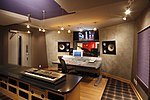Walter Kerr Theatre

The Walter Kerr Theatre, previously the Ritz Theatre, is a Broadway theater at 219 West 48th Street in the Theater District of Midtown Manhattan in New York City. The theater was designed by Herbert J. Krapp and was constructed for the Shubert brothers in 1921. The venue, renamed in 1990 after theatrical critic Walter Kerr, has 975 seats across three levels and is operated by Jujamcyn Theaters. The facade is made of plain patterned brick, with fire escapes in front of it. The auditorium contains Adam-style detailing, two balconies, and murals. The Shuberts developed the Ritz Theatre after World War I as part of a theatrical complex around 48th and 49th Streets. The Ritz Theatre opened on March 21, 1921, with the play Mary Stuart, and it was leased to William Harris Jr., who operated it for a decade. After many unsuccessful shows, the theater was leased to the Works Progress Administration's Federal Theatre Project from 1936 to 1939, then served as a CBS and NBC broadcasting studio. The Ritz briefly hosted legitimate shows in 1942 and 1943, and it again functioned as a studio for ABC until 1965. The Ritz was abandoned for several years until Eddie Bracken took over in 1970, renovating it and hosting several short-lived shows from 1971 to 1973. During the 1970s, the Ritz variously operated as a pornographic theater, vaudeville house, children's theater, and poster-storage warehouse. Jujamcyn took over in 1981 and reopened it two years later following an extensive restoration. The theater was renovated again in 1990 and renamed after Kerr.
Excerpt from the Wikipedia article Walter Kerr Theatre (License: CC BY-SA 3.0, Authors, Images).Walter Kerr Theatre
West 48th Street, New York Manhattan
Geographical coordinates (GPS) Address Website External links Nearby Places Show on map
Geographical coordinates (GPS)
| Latitude | Longitude |
|---|---|
| N 40.7606 ° | E -73.9856 ° |
Address
Walter Kerr Theatre
West 48th Street 219
10019 New York, Manhattan
New York, United States
Open on Google Maps











